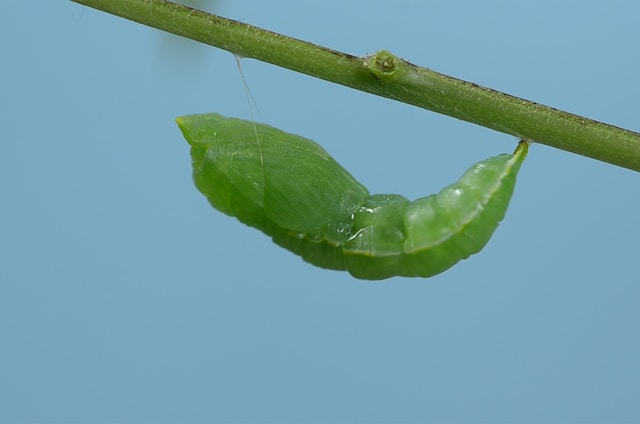Larvae are caterpillars that eat voraciously and grow rapidly, shedding their skin several times before entering the next stage. Pupae, on the other hand, do not feed but undergo dramatic changes inside their protective cocoon. The process of metamorphosis is fascinating and essential for the survival of butterflies. Through this transformational journey from egg to adult butterfly, they become more resilient and adaptive creatures with new abilities and features allowing them to thrive in different environments.
What is larva?
(Photo by Arjun MJ on Unsplash )

The larva stage is the first phase in a butterfly’s life cycle. This stage begins when the butterfly lays its eggs on a suitable host plant for the larvae to feed on. Once hatched, the larvae emerge as tiny caterpillars that spend their time eating and growing.
Caterpillars can grow rapidly during this phase, sometimes reaching up to 60 times their original size before they are ready to move on to the next stage of metamorphosis. During this time, they shed their skin several times and may go through different color variations depending on their species.
Larvae have voracious appetites and consume large amounts of food relative to their small size. They rely heavily on plants as a source of nourishment, but some species also eat other insects or even animal matter.
Despite being thought of as simple creatures with limited abilities, larvae demonstrate remarkable adaptations that allow them to survive in harsh environments. From camouflage tactics to toxic secretions, these little caterpillars are far from defenseless!
What is pupa?
(Photo by Bankim Desai on Unsplash )

Pupa is a stage in the life cycle of insects undergoing complete metamorphosis, such as butterflies, moths, and beetles. It is also known as the chrysalis or cocoon. The pupal stage comes after the larval stage and before the adult stage.
During this phase, many changes occur inside the pupa which transforms it into an adult insect. The old body parts are broken down, and new ones begin to form. These changes enable it to undergo significant transformations that will help them adapt better to their environment once they emerge.
The transformation process during this time varies based on species but typically lasts for several days up to a few weeks depending on environmental factors such as temperature and humidity levels.
While in its cocoon or chrysalis state, an insect becomes very vulnerable because it doesn’t move much or feed at all. However, some species have developed defense mechanisms like camouflage that protect them from predators while they wait for their transformation to complete.
Understanding what happens during this critical period can help us appreciate how incredible these creatures’ lives really are!
Larva Vs. Pupa – Key differences
One of the most significant differences between larva and pupa is their physical appearance. Larvae have elongated, worm-like bodies with well-defined heads, thoraxes, and abdomens. They often have numerous appendages such as legs or prolegs that aid in movement and feeding. On the other hand, pupae are characterized by a relatively immobile body encased within a protective cocoon or chrysalis.
Another key difference is their purpose during the butterfly’s life cycle. Larvae serve to consume food incessantly for growth while shedding multiple exoskeletons until they reach full maturity. In contrast, pupae act as an intermediary stage where the larvae undergo metamorphosis into adult butterflies through complex physiological changes.
The timing of these stages also varies significantly between larva and pupa phases. The larval stage can last anywhere from a few weeks to several months depending on environmental factors like temperature and food availability. Conversely, the pupal stage usually lasts around two weeks before emerging as adults once transformation has completed.
Understanding these crucial differences helps us appreciate how intricate butterfly development truly is!
The different stages of a butterfly’s life
Butterflies have a fascinating life cycle that begins with the egg stage. The female butterfly lays her eggs on the leaves or stems of plants that will provide food for the larvae when they hatch. These eggs are usually very small and are often laid in clusters.
Once hatched, the caterpillars emerge from their shells and begin to feed on the host plant. They grow rapidly during this stage, shedding their skin several times as they increase in size. Caterpillars can vary greatly in appearance depending on their species – some may be brightly colored and covered in hairs, while others may be more plain-looking.
After reaching full maturity, caterpillars enter into the pupal stage where they undergo metamorphosis. During this time, they spin themselves a cocoon or chrysalis which protects them as they transform into an adult butterfly.
After several days or even weeks depending on temperature and species-specific factors such as lighting conditions etc., adult butterflies emerge from their cocoons ready to find mates so that they can reproduce again starting back at square one of their unique life cycle!
The benefits of metamorphosis
The process of metamorphosis in insects allows them to undergo remarkable transformations throughout their lives. In the case of butterflies, this transformation provides many benefits for survival.
During the larval stage, a butterfly’s primary goal is to consume as much food as possible. This ensures that they have enough energy to survive the next phase of their life cycle – pupation. Once they enter into the pupal stage, their body undergoes significant changes that allow them to adapt and thrive in new environments.
Metamorphosis also allows butterflies to avoid competition with other organisms that may prey upon them during earlier stages of life. By changing their physical appearance and habits drastically, they can better evade predators and increase their chances for survival.
Moreover, metamorphosis enables butterflies to become more efficient pollinators by developing specialized mouthparts called proboscis during adulthood. These long straw-like structures enable butterflies to reach deep inside flowers without damaging them while collecting nectar and transferring pollen from one flower species to another.
Metamorphosis is essential for butterfly’s adaptation and survival in different ecosystems while providing unique benefits such as avoidance of competition with other organisms and becoming an effective pollinator.
How long does the pupa stage last?
The pupal stage is an important part of the butterfly’s life cycle, as it marks the transition from a larva into an adult. But how long does this stage last? Well, it depends on various factors such as environmental conditions and species.
In general, the pupal stage can last anywhere from several days to a few months. This duration varies depending on the temperature and humidity levels in their environment. Generally, warmer temperatures tend to speed up the process while colder temperatures slow it down.
During this stage, the caterpillar undergoes metamorphosis where its body transforms into that of an adult butterfly or moth. While inside its cocoon or chrysalis, there are significant changes happening within its body structure such as developing legs and wings.
For instance, Monarch butterflies’ pupal stages usually last between 10-14 days before they emerge as beautiful butterflies. On the other hand, some silk moths may take up to two years in their pupal stages!
Understanding how long a butterfly’s pupa lasts is crucial for anyone with a keen interest in these fascinating creatures. It helps us appreciate their unique life cycle even more!
What do pupae look like?
The pupal stage is a crucial phase in the life cycle of butterflies. During this period, a lot of changes occur within the cocoon, which ultimately transforms the larva into an adult butterfly. But what exactly do pupae look like?
Firstly, it’s important to note that not all pupae look alike. The appearance of a pupa depends on several factors such as species and environment. However, most pupae have similar characteristics.
Pupae are usually shaped like an obtuse angle with a tapered end at their posterior and broad rounded anterior ends. They come in various colors such as brown, green or gray depending on their surroundings.
Most importantly, they are covered by chitin shells that protect them from external danger and harsh weather conditions during metamorphosis.
As time goes by during the transformative phase, you may notice color changes or even movement inside some cocoons – signaling that something incredible is taking place! Ultimately leading to beautiful winged creatures emerging from these seemingly unremarkable shells.
What happens during the pupal stage?
The pupal stage is a crucial process in the life cycle of butterflies. During this stage, the larva transforms into an adult butterfly. But what exactly happens during this transformation?
Firstly, the caterpillar sheds its skin for one last time and forms a hard casing around itself called chrysalis or pupa. Once inside, it reorganizes all its bodily organs into their adult form. This process is known as histolysis.
Next, cells called imaginal discs start to grow and develop into various parts of the butterfly’s body such as wings, legs, antennae and eyes.
As development progresses within the chrysalis or pupa case, dark pigments appear on the developing wings revealing whether they will be colorful or plain in color once they emerge from their cocoon.
Interestingly enough – even though it may look like nothing is going on inside that little case – chemical changes are taking place which transform immature structures to fully functional ones with complex functions.
Finally after about 10-14 days (depending on species), when metamorphosis completes its course; signals trigger muscles within the chrysalis causing it to split open and reveal a beautiful new butterfly!
It’s amazing how much change can occur during just two weeks!
Featured Image By – Marek Piwnicki on Unsplash








